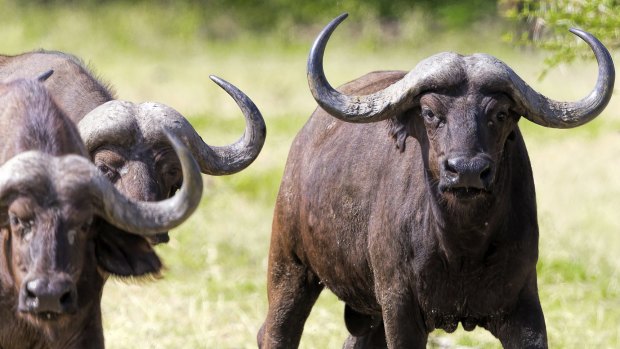This was published 9 years ago
How to survive South Africa's wildlife
Louise Southerden has the wildest taxi ride of her life, and gets a few survival tips, in South Africa.

Water buffalo: Not overly friendly charaters. Credit: iStock
Get into a taxi anywhere in the world and you'll soon learn your driver's opinions on the issues of the day. Get into a taxi in the wilds of South Africa, and you'll learn how to stay alive. At least that's how it is when my father and I catch a cab to Kruger airport after a four-day safari in Sabi Sands Game Reserve.
"My uncle was killed by an elephant, my cousin too, and my brother was killed by a buffalo," says our driver, Godfrey, as soon as Dad and I slide into the back seat of his air-conditioned sedan.
So begins the wildest taxi ride of my life. For two hours, we barrel along dusty roads – and get a local perspective on the wild animals we tourists come to see.
"I survived a lioness charge when I was 17," Godfrey says. "I was out collecting firewood with my uncle, and she came to within two metres of me, then walked away. I still don't know what made her leave.
"My brother and cousin survived a buffalo charge. Both were 14 or 15 at the time; my brother lost his left arm and was in a coma for two weeks."
Wait, wasn't your brother killed by a buffalo? I ask. "No," he snaps, eyeballing me in the rear vision mirror. "My friend was killed by a buffalo. My brother was killed by a black mamba [an African snake]."
Perhaps sensing we've had our fill of death-by-wildlife stories, he changes tack: "Do you know how to escape from a buffalo?" Dad and I prick up our ears; our next stop is Kenya's Masai Mara, where we'll be walking back into the food chain on a guided trek. "If there are trees around, climb a tree. Otherwise lie down. He can't gore you when you're on the ground. Or run out of sight and keep watching him.
"But if a lion charges you, never run," he says. That one I knew already, from Out of Africa. So what should you do? "Shout and clap your hands, make a noise. Don't look away. The most important things are to stand still and maintain eye contact. Though this will not help with an old male lion – if you stop and look at him, he will still come to kill you." Good to know. I think.
What about leopards? "This is also a big cat, but totally different to a lion. My grandfather used to tell us: don't look a leopard in the eye, or he will rip open your skull and take out your eyes." Has he ever shot at an animal, I ask, if only to scare it away? "Never. The best way to survive is to know each animal's behaviour."
Rules to live by, quite literally, but by the time we pull up outside Kruger's thatched airport terminal, my head is swimming with charging lions, elephants and buffalo. Helpful as he's been, it's all Dad and I can do to shake Godfrey's hand, give him a hefty tip and escape into the wildlife-free sanctuary of Kruger's busy airport – where we mingle with the other khaki-clad tourists who have come to Africa for close, but not too close, encounters with the Big Five.
Sign up for the Traveller Deals newsletter
Get exclusive travel deals delivered straight to your inbox. Sign up now.